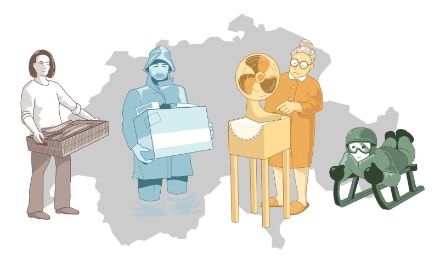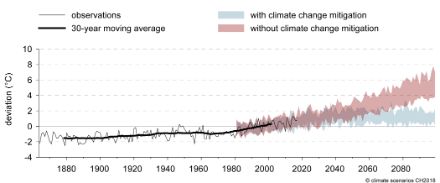Service Navigation
Search
Switzerland is not immune to global climate change. The Federal Office of Meteorology and Climatology, MeteoSwiss, is tasked by the federal government with producing climate scenarios on a regular basis in order to highlight the possible effects of climate change. These scenarios provide a basis for planning adaptation measures, as well as indicating the effect of global climate protection measures. In November 2018, the Swiss Climate Change Scenarios CH2018 were published, seven years after the previous Climate Change Scenarios CH2011. The scenarios were developed as one of the priority topics of the National Centre for Climate Services in close collaboration with ETH Zurich. The Climate Change Scenarios CH2018 reflect the current scientific findings on climate change in Switzerland and allow the most accurate view of the climate future of our country to date.

How are the Climate Change Scenarios produced?
The Climate Change Scenarios are produced with the help of computer simulations of climate models. These models are based on the laws of physics and depict the real climate processes in simplified form. Over 20 different climate models for Europe were refined using statistical methods to come up with the Swiss Climate Change Scenarios CH2018.
The primary cause of global climate change is the increase in greenhouse gas emission concentrations caused by human activity since industrialisation. In order to be able to calculate future changes in temperature, precipitation and other parameters, assumptions must be made about future global greenhouse gas emissions. To this end, so-called emission scenarios are defined on the basis of a number of assumptions about population growth, possible technological advancements and global political decisions. Climate change scenarios can therefore not be considered as predictions. Rather, they indicate the possible consequences for the climate if the greenhouse gas emissions rise unchecked or are, on the other hand, reduced.
Scenarios are produced for different future emission assumptions
Three potential emission scenarios are analysed for the purpose of the Swiss Climate Change Scenarios CH2018:
- “No climate-change mitigation”: This scenario is based on the assumption that greenhouse gas emissions will continue unabated. The scenario works on the basis of global emissions tripling by the end of the century.
- “Limited climate-change mitigation”: In this middle-ground scenario, technological advancements lead to reduced emissions of greenhouse gases. Nevertheless, the global temperature rises by more than 2°C compared to pre-industrial times.
- “Concerted climate mitigation efforts”: This scenario works on the assumption that there will be zero greenhouse gas emissions globally by 2070. Thereafter, the emissions in this scenario are actually negative – in other words, greenhouse gases will be removed from the atmosphere. The goals of the 2015 Paris Agreement would likely be achieved in this scenario, and global warming would remain under the 2°C increase compared to pre-industrial times.
The results of the “No climate-change mitigation” and “Concerted climate mitigation efforts” scenarios are shown here. The global greenhouse gas emissions in recent years have followed a similar trend to that of the “No climate mitigation” scenario.
The average temperature is rising
Climate change is leading to rising temperatures across the globe, including in Switzerland. If greenhouse gas emissions continue to increase in the future as per the “No climate mitigation” scenario, the average temperature will rise by 3.3-5.4°C compared to the 1981-2010 period by the end of the 21st century. On the other hand, if greenhouse gas emissions are rapidly and comprehensively reduced as per the “Concerted climate mitigation efforts” scenario, then the temperature increase can be restricted to less than 2°C in Switzerland.

The average precipitation amountsare changing
Precipitation will also change without concerted climate mitigation efforts. In summer, we may see up to 25% less precipitation by the middle of this century, while up to 20% increases are possible in the winter. At the moment, most parts of the country have more precipitation on average in the summer months than in the winter months. If the precipitation amounts change as a result of climate change, this will lead to a flattening of the yearly course.
Key messages of the Swiss Climate Change Scenarios CH2018
If unmitigated climate change leads to the changes described above in terms of temperature and precipitation, then there will be four foreseeable major consequences for Switzerland by the middle of this century: drier summers, heavier precipitation, more hot days and winters with little snow.
Drier summers
The increases in temperature mean that more water in the soils evaporates. Given that the average summer precipitation amounts are expected to decrease over the longer term, this will result in drier soils, fewer rain days and longer periods without precipitation. The western and southern parts of Switzerland are more severely affected by this than eastern Switzerland.
If greenhouse gas emissions continue unabated, the tendency towards drought conditions will continue to increase. Dry spells that have occurred once or twice per decade until now could be occuring every two years towards the end of the 21st century.
Heavy precipitation
Not only the measurements taken in the past but also the future climate change scenarios indicate that heavy precipitation events will become more frequent and more intense as a result of climate warming. By the middle of the 21st century, we can expect around a 10% increase in the heaviest one-day precipitation per year. This will apply irrespective of the season. Extreme precipitation events such as one-in-100-year events will similarly increase in intensity, by around 10% in winter and around 20% in summer.
As warmer air can hold more water (around 7% for every degree celsius), the increases in intensity of the heavy precipitation events stand to reason. The fluctuations over time in terms of heavy precipitation events are very large, however, and can deviate from the long-term trend for several years or decades.
More hot days
The maximum temperatures are increasing more markedly than the average temperatures. The reason for this is that when the soils becomes progressively drier, the cooling effect of evaporation is lessened. Hot days and warm nights are becoming more frequent and extreme, as are heat waves. This represents a health hazard for humans, and also places animals and plants under stress.
The lower-lying areas of Switzerland will have twice to three times as many hot days per year as they do now by the middle of the 21st century. In Basel/Binningen, for example, the number of hot days will increase from today’s 11 a year, to 23-28, and in Lugano from today’s 8 to 23-31 days.
Winters with little snow
The altitude of the zero-degree isotherm in winter will climb by the middle of the 21st century by 400 to 650 m. Today, the average altitude is on a similar level as the village of Einsiedeln (at around 900 masl), but will climb about to the altitude of Andermatt (1,400 masl). Due to climate warming in winter, more precipitation is falling in the form of rain rather than snow. This will result in a decrease in snowfall as well as snow cover. This means there will be fewer snowy regions in Switzerland.
Climate protection works
The climate change scenarios not only show how much Switzerland could warm up and what consequences that could have if greenhouse gas emissions continue to rise. But they also show clearly that climate protection measures work. The results of the “Concerted climate mitigation efforts” scenario are clear: A comprehensive reduction in global greenhouse gas emissions would significantly curb warming and further climatic changes in Switzerland.
A certain amount of warming would still occur, however, and we need to take steps to adapt to this. Thanks to the climate change scenarios, the climatic consequences can be studied in depth, and this knowledge can be employed to plan and implement adaptation measures. One example here are the hydrological scenarios Hydro-CH2018. In conjunction with the climate change scenarios CH2018, these hydrological scenarios estimate the effects of climate change on the water balance and water management in Switzerland. Regional information on climate change in the cantons and in the major regions is also available to assist the authorities and serve as a basis for climate-adapted decision making.
All the results of the climate change scenarios can be accessed in the CH2018 Web Atlas. These include the changes to climate variables according to emissions scenarios, the change over time of climate variables, climate indicators at measurement stations, and much more. The scientific details of the climate change scenarios can be found in the technical report.